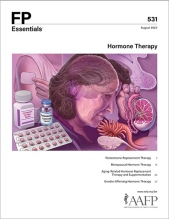
These key learning points summarize the consensus- and evidence-based recommendations included in this edition. The sources listed here for each statement recommend that physicians perform or implement these actions directly in a clinical setting.
1. Diagnose hypogonadism in men with a low testosterone level (ie, serum total testosterone level less than 300 to 350 ng/dL on two separate morning blood samples) and signs or symptoms of hypogonadism.
Evidence Rating: SORT C
Sources: BJU Int, Endocrine Society (ES), references 2 and 4
Websites: https://bjui-journals.onlinelibrary.wiley.com/doi/10.1111/bju.14899;
https://academic.oup.com/jcem/article/103/5/1715/4939465
2. After initiation of testosterone replacement therapy in men, measure the testosterone and hematocrit levels at 3 and 6 months (depending on the testosterone formulation), and at 12 months and at least annually thereafter.
Evidence Rating: SORT C
Source: Endocrine Society, reference 4
Website: https://academic.oup.com/jcem/article/103/5/1715/4939465
3. Do not prescribe hormone therapy (ie, combined estrogen and progestin) for primary prevention of chronic conditions in postmenopausal women.
Evidence Rating: SORT A
Source: U.S. Preventive Services Task Force (USPSTF), reference 40
Website: https://www.uspreventiveservicestaskforce.org/uspstf/recommendation/menopausal-hormone-therapy-preventive-medication
4. Consider prescribing menopausal hormone therapy for postmenopausal women with bothersome vasomotor symptoms who are younger than 60 years or within 10 years of menopause and have no contraindications.
Evidence Rating: SORT C
Source: North American Menopause Society (NAMS), reference 37
Website: https://www.menopause.org/docs/default-source/professional/nams-2022-hormone-therapy-position-statement.pdf
5. For transgender or gender-diverse adolescent patients who request pubertal suppression and meet eligibility criteria after a focused evaluation and informed consent process, prescribe a gonadotropin-releasing hormone agonist to suppress puberty when the patient reaches Tanner stage 2 or 3 (typically between ages 8-15 years).
Evidence rating: SORT B
Sources: World Professional Association for Transgender Health (WPATH), Endocr Rev, references 108 and 110
Websites: https://www.ncbi.nlm.nih.gov/pmc/articles/PMC9553112/; https://academic.oup.com/edrv/article/40/1/ 97/5123979
6. For transgender or gender-diverse adult patients who request and meet eligibility criteria for feminizing or masculinizing hormone therapy, perform a pretherapy evaluation to assess for contraindications and risk factors related to therapy. This should include a history, physical examination, and laboratory tests.
Evidence rating: SORT C
Sources: Endocrine Society, Endocr Rev, references 109 and 110
Websites: https://academic.oup.com/jcem/article/102/11/3869/4157558; https://academic.oup.com/edrv/article/40/1/97/5123979
Subscribe
From $350- Immediate, unlimited access to FP Essentials content
- 60 CME credits/year
- AAFP app access
- Print delivery available
Edition Access
$44- Immediate, unlimited access to this edition's content
- 5 CME credits
- AAFP app access
- Print delivery available
